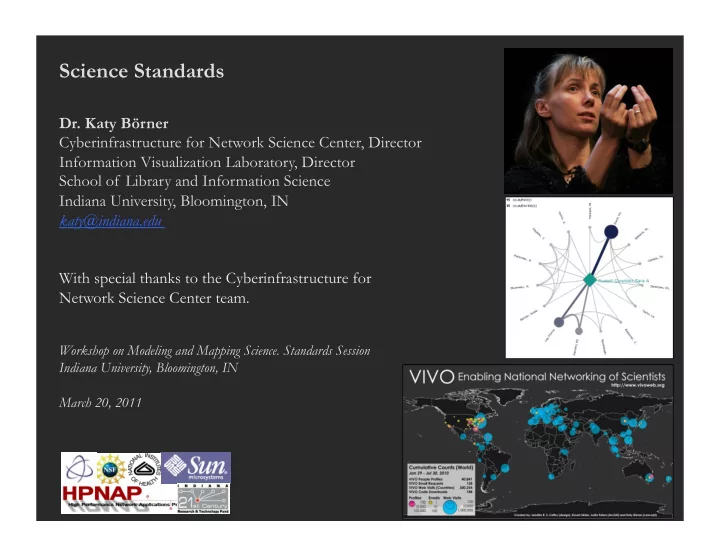

Science Standards Dr. Katy Börner Cyberinfrastructure for Network Science Center, Director Information Visualization Laboratory, Director School of Library and Information Science Indiana University, Bloomington, IN katy@indiana.edu With special thanks to the Cyberinfrastructure for Network Science Center team. Workshop on Modeling and Mapping Science. Standards Session Indiana University, Bloomington, IN March 20, 2011
Types of Standards Terminology Definitions of research front, invisible college, etc. See Ch1 in ModSciDyn book Metrics H-index, Impact Factors (see also relations to SAT, GRE, IQ scores) ScienceMetrics efforts to translate into different languages Science Map Reference Systems and Projections Locally and globally consistent maps What projections? What visual metaphors, visual languages/grammars? Alignment of Science Maps and Science with Ontologies/Taxonomies/ Classifications NCBO BioPortal Choices will depend on the ultimate usage of the maps. 2
Reference Systems and Projections 3
Authors are mortal. Papers are immortal. Monsters = ‘the unknown’ or voids. Impact of funding on science (yellow). Good and bad years. Hypothetical Model of the Evolution of Science - Daniel Zeller - 2007 4
Atlas of Science - Katy Borner - 2010 5
Science as accumulation of knowledge. “Scholarly brick laying”. Standing on the shoulders of giants. Densely knit communities. The importance of weak links. Hypothetical Model of the Evolution of Science - Daniel Zeller - 2007
Genealogy of Science OR Phylogeny of Science Katy Börner, Angela M. Zoss, and M'hamed el M Aisati, IU and Elsevier This is the first attempt to render Zeller’s “Hypothetical Model of the Evolution of Science” using real data; the 2001-2005 structure should resemble “Maps of Science: Forecasting Large Trends in Science” that was compiled from 7.2 million publications by Klavans and Boyack, both maps appeared in the 3rd Iteration of the exhibit.
Visual Languages 9
Social (People, Institutions) Cognitive (Terms, Papers, Patents, Journals) Regulations (Funding, Laws) Three node symbols have same area size for same weight. Undirected Combinations of weighted+directed+dotted (see below) are Directed possible. Unweighted Weighted Solid Direct link (citation) Dashed Co-occurrence (co-author, co-word) Dotted Co-citation (author CC, paper CC) Time, geo, topic are attributes. Use node/edge color coding for qualitative variables, e.g., type, gender, and area size coding for quantitative values, e.g., counts.
Visual Interfaces 11
Alignment of Science Maps and Science with Ontologies/Taxonomies/ Classifications 16
Hope for Today Identify different types of science standards existing major work on each type Key people But also examples of how other areas of science set standards, e.g., WC3 In preparation of a workshop in August 2011. The exhibit should support and promote standards. 19
All papers, maps, tools, talks, press are linked from http://cns.iu.edu 20
Recommend
More recommend